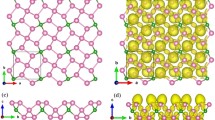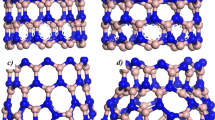Abstract
We apply an alloying strategy to single-layer PtN2 and PtP2, aiming to obtain a single-layer Pt–P–N alloy with a relatively low formation energy with reference to its bulk structure. We perform structure search based on a cluster-expansion method and predict single-layer and bulk PtPN consisting of pentagonal networks. The formation energy of single-layer PtPN is significantly lower in comparison with that of single-layer PtP2. The predicted bulk structure of PtPN adopts a structure that is similar to the pyrite structure. We also find that single-layer pentagonal PtPN, unlike PtN2 and PtP2, exhibits a sizable, direct PBE band gap of 0.84 eV. Furthermore, the band gap of single-layer pentagonal PtPN calculated with the hybrid density functional theory is 1.60 eV, which is within visible light spectrum and promising for optoelectronics applications. In addition to predicting PtPN in the 2D and 3D forms, we study the flexural rigidity and electronic structure of PtPN in the nanotube form. We find that single-layer PtPN has similar flexural rigidity to that of single-layer carbon and boron nitride nanosheets and that the band gaps of PtPN nanotubes depend on their radii. Our work shed light on obtaining an isolated 2D planar, pentagonal PtPN nanosheet from its 3D counterpart and on obtaining 1D nanotubes with tunable band gaps.












Similar content being viewed by others
References
Farmer DB, Lin Y-M, Avouris P (2010) Graphene field-effect transistors with self-aligned gates. Appl Phys Lett 97:013103
Eda G, Fanchini G, Chhowalla M (2008) Large-area ultrathin films of reduced graphene oxide as a transparent and flexible electronic material. Nat Nanotechnol 3:270
Wu J, Becerril HA, Bao Z, Liu Z, Chen Y, Peumans P (2008) Organic solar cells with solution-processed graphene transparent electrodes. Appl Phys Lett 92:237
Dean JJ, van Driel HM (2009) Second harmonic generation from graphene and graphitic films. Appl Phys Lett 95:261910
Xia F, Mueller T, Lin YM, Valdes-Garcia A, Avouris P (2009) Ultrafast graphene photodetector. Nat Nanotechnol 4:839
Wang H, Xu Z, Kohandehghan A, Li Z, Cui K, Tan X, Stephenson TJ, King’Ondu CK, Holt CM, Olsen BC (2013) Interconnected carbon nanosheets derived from hemp for ultrafast supercapacitors with high energy. ACS Nano 7:5131–5141
Raccichini R, Varzi A, Passerini S, Scrosati B (2015) The role of graphene for electrochemical energy storage. Nat Mater 14:271
Liu Q, Chen C, Du M, Wu Y, Ren C, Ding K, Song M, Huang C (2018) Porous hexagonal boron nitride sheets: effect of hydroxyl and secondary amino groups on photocatalytic hydrogen evolution. ACS Appl Nano Mater 1:4566–4575
Li L, Gong P, Sheng D, Wang S, Wang W, Zhu X, Shi X, Wang F, Han W, Yang S (2018) Highly in-plane anisotropic 2D GeAs2 for polarization-sensitive photodetection. Adv Mater 30:1804541
Rao M (2017) Exhaustive search of convex pentagons which tile the plane. arXiv preprint arXiv:1708.00274
Liu Z, Wang H, Sun J, Sun R, Wang Z, Yang J (2018) Penta-Pt2N4: an ideal two-dimensional material for nanoelectronics. Nanoscale 10:16169–16177
Liu L, Zhuang HL (2018) PtP2: an example of exploring the hidden Cairo tessellation in the pyrite structure for discovering novel two-dimensional materials. Phys Rev Mater 2:114003
Yuan J-H, Song Y-Q, Chen Q, Xue K-H, Miao X-S (2019) Single-layer planar penta-X2N4 (X = Ni, Pd and Pt) as direct-bandgap semiconductors from first principle calculations. Appl Surf Sci 469:456–462
Zhao K, Li X, Wang S, Wang Q (2019) 2D planar penta-MN 2 (M = Pd, Pt) sheets identified through structure search. Phys Chem Chem Phys 21:246–251
Liu L, Wang D, Lakamsani S, Huang W, Price C, Zhuang HL (2019) Dimension engineering of single-layer PtN2 with the Cairo tessellation. J Appl Phys 125:204302
Crowhurst JC, Goncharov AF, Sadigh B, Evans CL, Morrall PG, Ferreira JL, Nelson A (2006) Synthesis and characterization of the nitrides of platinum and iridium. Science 311:1275–1278
Thomassen L (1929) Über kristallstrukturen einiger binärer verbindungen der platinmetalle II. Z Phys Chem 4:277–287
Kresse G, Furthmüller J (1996) Efficient iterative schemes for ab initio total-energy calculations using a plane-wave basis set. Phys Rev B 54:11169
Perdew JP, Burke K, Ernzerhof M (1996) Generalized gradient approximation made simple. Phys Rev Lett 77:3865
Blöchl PE (1994) Projector augmented-wave method. Phys Rev B 50:17953
Kresse G, Joubert D (1999) From ultrasoft pseudopotentials to the projector augmented-wave method. Phys Rev B 59:1758
Monkhorst HJ, Pack JD (1976) Special points for Brillouin-zone integrations. Phys Rev B 13:5188
Van De Walle A, Asta M, Ceder G (2002) The alloy theoretic automated toolkit: a user guide. Calphad 26:539–553
Mann C, McLoud-Mann J, Von Derau D (2018) Convex pentagons that admit i-block transitive tilings. Geom Dedic 194:141–167
Ge HJS, Ernzerhof M (2006) Erratum: “Hybrid functionals based on a screened Coulomb potential” [J Chem Phys 118, 8207 (2003)]. J Chem Phys 124:219906
Singh AK, Mathew K, Zhuang HL, Hennig RG (2015) Computational screening of 2D materials for photocatalysis. J Phys Chem Lett 6:1087–1098
Fu D, Zhao X, Zhang Y-Y, Li L, Xu H, Jang A-R, Yoon SI, Song P, Poh SM, Ren T (2017) Molecular beam epitaxy of highly crystalline monolayer molybdenum disulfide on hexagonal boron nitride. J Am Chem Soc 139:9392–9400
Cherian R, Mahadevan P (2007) Elastic properties of carbon nanotubes: an atomistic approach. J Nanosci Nanotechnol 7:1779–1782
Landau LD, Lifshitz EM (1970) Theory of elasticity, 2nd edn. Pergamon Press, Oxford, pp 62–66
Kudin KN, Scuseria GE, Yakobson BI (2001) C2F, BN, and C nanoshell elasticity from ab initio computations. Phys Rev B 64:235406
Ru CQ (2000) Effective bending stiffness of carbon nanotubes. Phys Rev B 62:9973–9976
Pantano A, Parks DM, Boyce MC (2004) Mechanics of deformation of single- and multi-wall carbon nanotubes. J Mech Phys Solids 52:789–821
Janas D (2018) Towards monochiral carbon nanotubes: a review of progress in the sorting of single-walled carbon nanotubes. Mater Chem Front 2:36–63
Qian S, Sheng X, Xu X, Wu Y, Lu N, Qin Z, Wang J, Zhang C, Feng E, Huang W (2019) Penta-MX 2 (M = Ni, Pd and Pt; X = P and As) monolayers: direct band-gap semiconductors with high carrier mobility. J Mater Chem C 7:3569–3575
Acknowledgements
We thank the start-up funds from Arizona State University. This research used the computational resources of the AGAVE computer cluster at Arizona State University.
Author information
Authors and Affiliations
Corresponding author
Additional information
Publisher's Note
Springer Nature remains neutral with regard to jurisdictional claims in published maps and institutional affiliations.
Rights and permissions
About this article
Cite this article
Wang, D., Liu, L. & Zhuang, H.L. Toward obtaining 2D and 3D and 1D PtPN with pentagonal pattern. J Mater Sci 54, 14029–14037 (2019). https://doi.org/10.1007/s10853-019-03886-x
Received:
Accepted:
Published:
Issue Date:
DOI: https://doi.org/10.1007/s10853-019-03886-x




